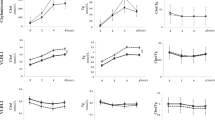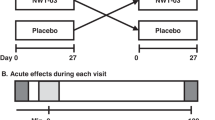Abstract
Background/Objectives:
Viscous fibers typically reduce total cholesterol (TC) by 3–7% in humans. The cholesterol-lowering properties of the viscous fiber pectin may depend on its physico-chemical properties (viscosity, molecular weight (MW) and degree of esterification (DE)), but these are not typically described in publications, nor required by European Food Safety Authority (EFSA) with respect to its generic pectin cholesterol-lowering claim.
Subjects/Methods:
Here, different sources and types of well-characterized pectin were evaluated in humans. Cross-over studies were completed in mildly hyper-cholesterolemic persons receiving either 15 g/day pectin or cellulose with food for 4 weeks.
Results:
Relative low-density lipoprotein (LDL) cholesterol (LDL-C) lowering was as follows: citrus pectin DE-70=apple pectin DE-70 (7–10% reduction versus control)>apple pectin DE-35=citrus pectin DE-35>OPF (orange pulp fiber) DE-70 and low-MW pectin DE-70>citrus DE-0. In a subsequent 3-week trial with 6 g/day pectin, citrus DE-70 and high MW pectin DE-70 reduced LDL-C 6–7% versus control (without changes in TC). In both studies, high DE and high MW were important for cholesterol lowering. Source may also be important as citrus and apple DE-70 pectin were more effective than OPF DE-70 pectin. Pectin did not affect inflammatory markers high-sensitivity C-reactive protein (hsCRP) nor plasma homocysteine.
Conclusions:
Pectin source and type (DE and MW) affect cholesterol lowering. The EFSA pectin cholesterol-lowering claim should require a minimum level of characterization, including DE and MW.
This is a preview of subscription content, access via your institution
Access options
Subscribe to this journal
Receive 12 print issues and online access
$259.00 per year
only $21.58 per issue
Buy this article
- Purchase on Springer Link
- Instant access to full article PDF
Prices may be subject to local taxes which are calculated during checkout
Similar content being viewed by others
References
Akaike H (1974). A new look at the statistical identification model. IEEE Trans Automat Contr 19, 716–723.
Akaike H (1987). Factor analysis and AIC. Psychometrika 52, 317–332.
Baker RA (1997). Reassessment of somefruit and vegetable pectin levels. J Food Res 62, 225–229.
Brown L, Rosner B, Willett WW, Sacks FM (1999). Cholesterol-lowering effects of dietary fiber: a meta-analysis. Am J Clin Nutr 69, 30–42.
Centraal Begeleidingsorgaan voor de Intercollegiale Toetsing (1998). Syllabus Behandeling en Preventie van Coronaire Hartziekten Door Verlaging van de Plasmacholesterolconcentratie. Centraal Begeleidingsorgaan voor de Intercollegiale Toetsing: Utrecht, The Netherlands.
Cerda JJ (1988). The role of grapefruit pectin in health and disease. Trans Am Clin Climatol Assoc 99, 203–213.
Cerda JJ, Robbins FL, Burgin CW, Baumgartner TG, Rice RW (1988). The effects of grapefruit pectin on patients at risk for coronary heart disease without altering diet or lifestyle. Clin Cardiol 11, 589–594.
Craig WM, Shelton S, Cook D (2006). Effect of Different Pectin Sources on Total Serum Cholesterol of Broilers Internal report, Elk River USA, Cargill Animal Nutrition Innovation Center Innovation Study Report No. 2605-147.
Dongowski G (1997). Effect of pH on the in vitro interactions between bile acids and pectin. Z Lebensm Unters Forsch 205, 185–192.
Dongowski G, Lorenz A (2004). Intestinal steroids in rats are influenced by the structural parameters of pectin. J Nutr Biochem 15, 196–205.
Duvetter T, Sila DN, Van Buggenhout S, Jolie R, Van Loey A, Hendrickx M (2009). Pectins in processed fruits and vegetables: Part I—stability and catalytic activity of pectinases. Compr Rev Food Sci Food Safety 8, 75–85.
EFSA (2010). Scientific Opinion on the substantiation of health claims related to pectin and reduction of post-prandial glycaemic responses (ID 786), maintenance of normal blood cholesterol concentrations (ID 818) and increase in satiety leading to a reduction in energy intake (ID 4692) pursuant to Article 13(1) of Regulation (EC) No 1924/20061. EFSA J 8, 174.
Fernandez ML (1995). Distinct mechanisms of plasma LDL lowering by dietary fiber in the guinea pig: specific effects of pectin, guar gum, and psyllium. J Lipid Res 36, 2394–2404.
Fernandez ML, Sun DM, Tosca MA, McNamara DJ (1994). Citrus pectin and cholesterol interact to regulate hepatic cholesterol homeostasis and lipoprotein metabolism: a dose–response study in guinea pigs. Am J Clin Nutr 59, 869–878.
Friedewald WT, Levy RI, Fredrickson DS (1972). Estimation of the concentration of low-density lipoprotein cholesterol in plasma, without use of the preparative ultracentrifuge. Clin Chem 18, 499–502.
Garcia-Diez F, Garcia-Mediavilla V, Bayon JE, Gonzalez-Gallego J (1996). Pectin feeding influences fecal bile acid excretion, hepatic bile acid and cholesterol synthesis and serum cholesterol in rats. J Nutr 126, 1766–1771.
Gorinstein S, Leontowicz H, Leontowicz M, Drzewiecki J, Jastrzebski Z, Tapia MS et al. (2005). Red Star Ruby (Sunrise) and blond qualities of Jaffa grapefruits and their influence on plasma lipid levels and plasma antioxidant activity in rats fed with cholesterol-containing and cholesterol-free diets. Life Sci 77, 2384–2397.
Gunness P, Gidley MJ (2010). Mechanisms underlying the cholesterol-lowering properties of soluble dietary fibre polysaccharides. Food Funct 1, 149–155.
Hagan RL (1993). Determination of plasma homocysteine by HPLC with fluorescence detection: a survey of current methods. J Liquid Chromatogr Relat Technol 16, 2701–2714.
Ide T, Horii M (1989). Predominant conjugation with glycine of biliary and lumen bile acids in rats fed on pectin. Br J Nutr 61, 545–557.
Ide T, Horii M, Yamamoto T, Kawashima K (1990). Contrasting effects of water-soluble and water-insoluble dietary fibers on bile acid conjugation and taurine metabolism in the rat. Lipids 25, 335–340.
Ismail MF, Gad MZ, Hamdy MA (1999). Study of the hypolipidemic properties of pectin, garlic and ginseng in hypercholesterolemic rabbits. Pharmacol Res 39, 157–166.
JECFA (2009). Compendium of Food Additive Specifications: Monographs 7, 68th meeting. Joint FAO/WHO Expert Committee on Food Additives: Rome.
Krzysik M, Grajeta H, Prescha A, Weber R (2011). Effect of cellulose, pectin and chromium(III) on lipid and carbohydrate metabolism in rats. J Trace Elem Med Biol 25, 97–102.
Levene H (1960). Robust test for equality of variances. Contributions to Probability and Statistics. Stanford University Press: Palo Alto, CA.
Martinez de Prado MT, Sanchez-Muniz FJ, Katan MB, Hermus RJ (1981). The effect of different fiber sources on the neutral steroid excretions of hypercholesterolemic casein fed rabbits. Rev Esp Fisiol 37, 407–412.
Palmer GH, Dixon DG (1966). Effect of pectin dose on serum cholesterol levels. Am J Clin Nutr 18, 437–442.
Peng G (2004). Testing Normality of Data Using SAS. PharmaSUG 2004; May 22–26, 2004: San Diego, California.
Ralet M-C, Axelos MAV, Thibault J-F (1994). Gelation properties of extruded lemon cell walls and their water-soluble pectins. Carbohyd Res 260, 271–282.
Reiser S (1987). Metabolics effects of dietary pectins related to human health. Food Technol 41, 91–99.
Shapiro SS, Wilk MB (1965). An analysis of variance test for normality (complete samples). Biometrika 52, 591–611.
Sila DN, Van Buggenhout S, Duvetter T, Fraeye I, De Roeck A, Van Loey A et al. (2009). Pectins in processed fruits and vegetables: Part II—structure–function relationships. Compr Rev Food Sci Food Safety 8, 86–104.
Snedecor GW, Cochran WG (1980). Statistical Methods, 7th edn. Iowa State University Press: Ames, Iowa.
Terpstra AH, Lapre JA, de Vries HT, Beynen AC (2002). The hypocholesterolemic effect of lemon peels, lemon pectin, and the waste stream material of lemon peels in hybrid F1B hamsters. Eur J Nutr 41, 19–26.
Theuwissen E, Mensink RP (2008). Water-soluble dietary fibers and cardiovascular disease. Physiol Behav 94, 285–292.
Thibault J-F, Ralet M-C (2008). Pectins, their origin, structure and functions. In: McCleary BV, Prosky L (eds). Advanced Dietary Fibers Technology. Blackwell Science Ltd: Oxford, UK, doi: 10.1002/9780470999615.ch32, pp 369–376.
Trautwein EA, Kunath-Rau A, Erbersdobler HF (1998). Effect of different varieties of pectin and guar gum on plasma, hepatic and biliary lipids and cholesterol gallstone formation in hamsters fed on high-cholesterol diets. Br J Nutr 79, 463–471.
Vergara-Jimenez M, Furr H, Fernandez ML (1999). Pectin and psyllium decrease the susceptibility of LDL to oxidation in guinea pigs. J Nutr Biochem 10, 118–124.
Yamaguchi F, Uchida S, Watabe S, Kojima H, Shimizu N, Hatanaka C (1995). Relationship between molecular weights of pectin and hypocholesterolemic effects in rats. Biosci Biotechnol Biochem 59, 2130–2131.
Acknowledgements
This study was funded by a research grant from Cargill European R&D Center (Vilvoorde, Belgium).
Author information
Authors and Affiliations
Corresponding author
Ethics declarations
Competing interests
Professor Brouns is an academic researcher and science consultant to Cargill. Dr Elke Theuwissen is an independent academic researcher at Maastricht University. Dr Adam (at time of study) was a nutrition scientist at Cargill Inc. (Vilvoorde, Belgium). Dr Bell is an independent Biostatistician at Clinical Data Services (Bloomington, IN, USA). Dr and Professor Berger is North American Nutrition Leader in Global Food Research at Cargill Inc. (Minneapolis, MN, USA). Professor Mensink is an independent academic researcher at Maastricht University.
Rights and permissions
About this article
Cite this article
Brouns, F., Theuwissen, E., Adam, A. et al. Cholesterol-lowering properties of different pectin types in mildly hyper-cholesterolemic men and women. Eur J Clin Nutr 66, 591–599 (2012). https://doi.org/10.1038/ejcn.2011.208
Received:
Revised:
Accepted:
Published:
Issue Date:
DOI: https://doi.org/10.1038/ejcn.2011.208
Keywords
This article is cited by
-
Multi-objective optimization of pectin extraction from orange peel via response surface methodology: yield and degree of esterification
Journal of Food Measurement and Characterization (2022)
-
The Dietary Fiber Pectin: Health Benefits and Potential for the Treatment of Allergies by Modulation of Gut Microbiota
Current Allergy and Asthma Reports (2021)
-
Analysis of physiochemical composition and antioxidant properties between hulls of the genetically modified glyphosate-tolerant soybean and northeast soybean
Food Science and Biotechnology (2021)
-
Tiered approach for the identification of Mal d 1 reduced, well tolerated apple genotypes
Scientific Reports (2020)
-
Optimization of oil and pectin extraction from orange (Citrus sinensis) peels: a response surface approach
Journal of Analytical Science and Technology (2018)



